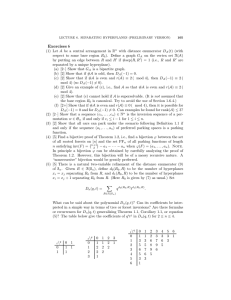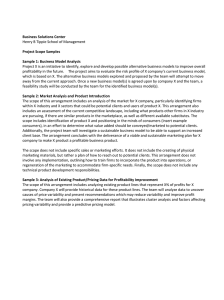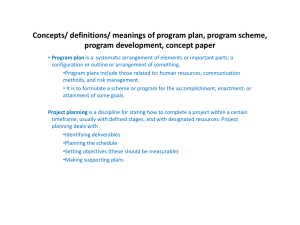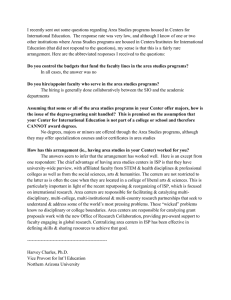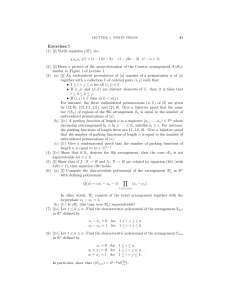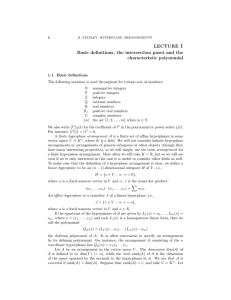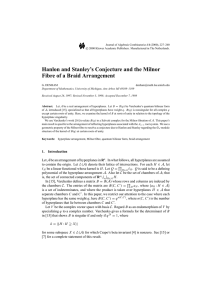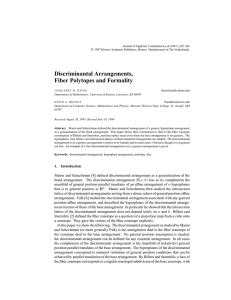ADDITIONAL 18.217 PROBLEMS
advertisement
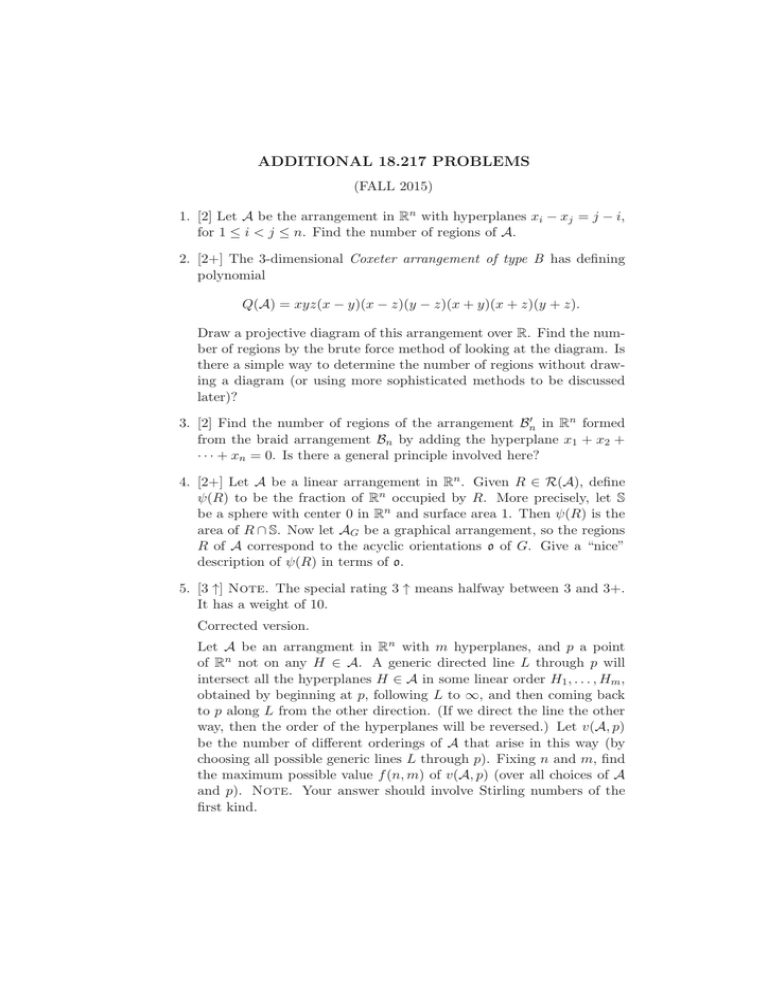
ADDITIONAL 18.217 PROBLEMS (FALL 2015) 1. [2] Let A be the arrangement in Rn with hyperplanes xi − xj = j − i, for 1 ≤ i < j ≤ n. Find the number of regions of A. 2. [2+] The 3-dimensional Coxeter arrangement of type B has defining polynomial Q(A) = xyz(x − y)(x − z)(y − z)(x + y)(x + z)(y + z). Draw a projective diagram of this arrangement over R. Find the number of regions by the brute force method of looking at the diagram. Is there a simple way to determine the number of regions without drawing a diagram (or using more sophisticated methods to be discussed later)? 3. [2] Find the number of regions of the arrangement Bn′ in Rn formed from the braid arrangement Bn by adding the hyperplane x1 + x2 + · · · + xn = 0. Is there a general principle involved here? 4. [2+] Let A be a linear arrangement in Rn . Given R ∈ R(A), define ψ(R) to be the fraction of Rn occupied by R. More precisely, let S be a sphere with center 0 in Rn and surface area 1. Then ψ(R) is the area of R ∩ S. Now let AG be a graphical arrangement, so the regions R of A correspond to the acyclic orientations o of G. Give a “nice” description of ψ(R) in terms of o. 5. [3 ↑] Note. The special rating 3 ↑ means halfway between 3 and 3+. It has a weight of 10. Corrected version. Let A be an arrangment in Rn with m hyperplanes, and p a point of Rn not on any H ∈ A. A generic directed line L through p will intersect all the hyperplanes H ∈ A in some linear order H1 , . . . , Hm , obtained by beginning at p, following L to ∞, and then coming back to p along L from the other direction. (If we direct the line the other way, then the order of the hyperplanes will be reversed.) Let v(A, p) be the number of different orderings of A that arise in this way (by choosing all possible generic lines L through p). Fixing n and m, find the maximum possible value f (n, m) of v(A, p) (over all choices of A and p). Note. Your answer should involve Stirling numbers of the first kind. 6. [3–] Let Bn denote the braid arrangement of dimension n (over any field), and let Dn denote the arrangement obtained from Bn by adjoining all hyperplanes xi = 0, 1 ≤ i ≤ n. Express χDn (t) in terms of χBn (t). Use Whitney’s theorem and not some other method. Note. The polynomial χBn (t) is given by Corollary 2.2, but this should not be relevant to your solution. 7. (a) [2] Let B3 be the braid arrangement in K 3 , so QB3 = (x − y)(x − z)(y − z). Find an explicit homogeneous basis for the K[x, y, z]module E(B3 ) defined in class. (Proof not required.) (b) Q [2+] Do the same for the braid arrangement Bn with QBn = 1≤i<j≤n (xi − xj ). (Again no proof is required.) 8. [2+] Prove the result mentioned in class that if C is a cycle with at least four vertices, then the graphical arrangement AC is not free. You may use any result stated in class about free arrangements, except of course the result that AG is free if and only if AG is supersolvable. 9. [5] Find a “reasonable” description of the characteristic polynomial (or even the number of regions) of the arrangement in Rn with hyperplanes xi + xj + xk = 0, 1 ≤ i < j < k ≤ n. 10. [5–] Find the number of n-element left-regular bands up to isomorphism for small n. (Of course the difficulty depends on the value of n. I don’t know of anyone, including myself, who has looked at this problem.) Note. A band is a semigroup for which every element x is idempotent (x2 = x). The number of them up to isomorphism and antiisomorphism is A002788 of OEIS. 11. [3] Show that if we apply the top-to-random shuffle r times to the deck [n], then the probability that we obtain a cycle of length n is 1/n. (I am not really sure of the difficulty of this problem.) For example, when r = 1 the only one of the n shuffles that gives an n-cycle is the one that puts the top card on the bottom. 12. [3] Let p : S → R be a probability distribution on a (finite) left-regular band S. Let C be the set of chambers of S. Show that the action of w on RC (by left multiplication) is diagonalizable. 13. [2+] A left regular band S is generated by n elements x1 , . . . , xn . What is the most number N of elements that S can have? (You need to construct an LRB with N elements and show that you can’t have more elements.) 14. [2+↑] (i.e, weight 4) Let A be a real arrangement and F(A) the corresponding LRB on the nonempty faces of A. Show that F(A) has a unique minimal generating set, and describe its elements. Note. You may use the following standard fact. Let P be a convex polyhedron in Rn , i.e., an intersection of finitely many half-spaces α · x ≤ c. Let r be the minimum dimension of any face of P. Then the face poset of P is graded, with rank function rank(F ) = dim(F ) − r. 15. [5–] Does every finite LRB have a unique minimal set of generators? (I just made up this problem, so the difficulty level might be low.)
